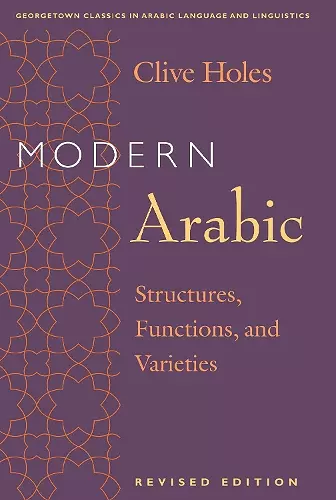Modern Arabic
Structures, Functions, and Varieties, Revised Edition
Format:Paperback
Publisher:Georgetown University Press
Published:3rd Sep '04
Currently unavailable, and unfortunately no date known when it will be back

"Even seasoned Arabists can profit from this hefty tome, the first of its kind to serve as a solid introduction to the entire field of of Arabic linguistics and Comparative Arabic dialectology."
Traces the development of the Arabic language from Classical Arabic through the symbiotic use of Modern Standard Arabic or MSA. This title explains the structural characteristics - phonology, morphology, syntax, semantics, and lexical and stylistic developments. It also shows how native speakers use both types of Arabic for different purposes.The revised and updated edition of "Modern Arabic" takes this authoritative, concise linguistic description of the structure and use of modern Arabic to an invaluable new level. Clive Holes traces the development of the Arabic language from Classical Arabic, the written language used in the 7th century for the Qur'an and poetry, through the increasingly symbiotic use of Modern Standard Arabic or MSA (the language of writing and formal speech) and dialectal Arabic (the language of normal conversation). He shows how Arabic has been shaped over the centuries by migration, urbanization, and education - giving us "a balanced, dispassionate, and accurate picture of the structures, functions, and varieties of the contemporary Arabic language". Holes explains the structural characteristics - phonology, morphology, syntax, semantics, and lexical and stylistic developments - that the majority of the dialects share, as distinguished from Modern Standard Arabic. He also shows how native speakers use both types of Arabic for different purposes, with MSA being the language of power and control as used on television and in political speeches, and the dialects serving as the language of intimacy and domesticity. He further shows how MSA and spoken dialects are not as compartmentalized as one might be led to believe. "Modern Arabic" illustrates the use of the Arabic language in real life, whether in conversation, news bulletins and newspaper articles, serious literature, or song. This new edition takes into account research published in several areas of Arabic linguistics since the first edition was published in 1995. It includes more extensive comment on the North African Arabic vocabulary of Modern Standard Arabic, more information about "mixed" varieties of written Arabic that are not in MSA (especially in Egypt), updated references, explanations, and many new examples. All Arabic is transcribed, except for an appendix presenting the Arabic alphabet and script. Students of the Arabic language will find "Modern Arabic" without peer - as will those general linguists who are interested in discovering how Arabic compares structurally and sociolinguistically with European languages.
Thanks to Clive Holes we now have a book that examines in some depth the relationship between the spoken and written language, and which provides us with a lively and erudite account of the current state of the Arabic language in its many forms... It is really in the areas of phonology, morphology and syntax that Holes is at his best, drawing on his vast experience of field work and profound linguistic knowledge. His assessment of modern Arabic in all its forms is honest, contrastive and comparative, and presents impressions and analyses of many categories from a fresh angle. It will appeal to anyone with an interest in the Arabic language today. Bibliotheca Orientalis Clive Holes's book is written in a pleasantly informal manner. Matters are discussed throughout in a knowledgeable, objective and informative fashion and presented in a lively, readable style... The author has no theoretical axe to grind, he is bound to no one school of thought and has no interest in supporting the cause of any particular doctrine. His approach to the material and the problems it raises is refreshingly straightforward and characterized at all points by the simple application of common sense and the desire to see the truth for what it is. This is in welcome contrast to much recent work in Arabic linguistics, which suffers, as Holes observes in his preface, from a regrettable reluctance to see things as they are. His book is a deliberate, and very successful, attempt to redress the balance. It will be read with pleasure and benefit by all who are interested in the Arabic language... An excellent book and will surely become a standard work on the subject. It will be read with much profit by all interested in the Arabic language, to whom it is herewith heartily recommended. Zeitschrift fur Arabische Linguistik In a pleasant and extremely clear style on which he must be complimented, the author puts at the disposition of a large readership, from advanced students of Arabic to general linguists, an excellent synthesis of the relationships between written Arabic, spoken standard Arabic, the spoken dialects and relationships between the dialects. It was only natural that Clive Holes's work would benefit from our improved knowledge of dialectal Arabic, but these improvements would have been insufficient without the author's remarkable powers of synthesis and his ability to capture sociolinguistic phenomena. One can only warmly recommend a work which is agreeably accessible at the same time as rigorously scientific, and which opens paths for future research, which one hopes will be explored by the community of Arabists. [Translated from French] Journal of Semitic Studies
ISBN: 9781589010222
Dimensions: unknown
Weight: 590g
440 pages
Revised Edition